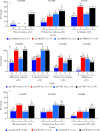[Comparison of clinical and immunological features between clinically amyopathic dermatomyositis and typical dermatomyositis]
- PMID: 33331305
- PMCID: PMC7745270
- DOI: 10.19723/j.issn.1671-167X.2020.06.003
[Comparison of clinical and immunological features between clinically amyopathic dermatomyositis and typical dermatomyositis]
Abstract
Objective: To study the differences between clinically amyopathic dermatomyositis (CADM) and typical dermatomyositis (DM) on clinical and immunological features.
Methods: By collecting clinical data of 106 CADM patients and 158 DM patients from January 2010 to June 2019 in the department of Rheumatology and Immunology, Peking University People's Hospital, the clinical characteristics and immunological features in the two groups were compared, and the distribution characters and the clinical meanings of myositis autoantibodies were discussed in the two groups respectively. Myositis autoantibodies were measured by immunoblotting according to the manufacturers' instructions.
Results: In the aspects of clinical manifestations, CADM presented more with onset of interstial lung diseases (ILD) compared with DM (20.7% vs. 7.6%, P=0.002), and CADM-ILD was more likely to be acute ILD (58.3% vs. 26%, P < 0.001), and there were no differences between CADM and DM in cutaneous manifestations, accompanied with connective tissue disease (CTD) and malignancy. In CADM, the positive rate of rheumatoid factors and antinuclear antibodies was lower in DM. The most common myositis specific autoantibodies (MSAs) in CADM were anti-MDA5 (36%), anti-PL-7 (11.2%) and anti-TIF-1γ (10.1%). The most common MSAs in DM were anti-Jo-1 (19.2%), anti-TIF-1γ (11.5%) and anti-MDA5 (11.5%). Anti-MDA5 was correlated with acute ILD and skin ulceration both in CADM and DM; in CADM, skin ulceration was not associated with the titer of anti-MDA5; while in DM, skin ulceration was associated with high titer of anti-MDA5. In DM, anti-TIF-1γ was correlated with heliotrope eruption, V/shawl neck sign, perionychia erythma and malignancy, and higher rate of malignancy was seen in all titers of the anti-TIF-1γ positive patients. In CADM, anti-TIF1-γ showed no correlation with clinical manifestations. The most common myositis associated autoantibody was anti-Ro-52 both in CADM and DM. In CADM, anti-Ro-52 was associated with Raynaud's phenomenon and chronic ILD, while in DM, anti-Ro-52 was associated with mechanic's hands, noninfectious fever and accompanied CTD.
Conclusion: Compared with DM, ILD is more likely to be acute in CADM. It is different between CADM and DM about the distribution of myositis autoantibodies and the clinical significance of the same myositis antibody, and the clinical significance of some myositis antibodies is related to titers.
目的: 比较临床无肌病性皮肌炎(clinically amyopathic dermatomyositis, CADM)和皮肌炎(dermatomyositis, DM)的临床及免疫学特征。
方法: 选择2010年1月—2019年12月在北京大学人民医院风湿免疫科住院的106例CADM和158例DM患者的病例资料进行回顾性分析,对两组患者的临床及免疫学指标进行比较,探讨肌炎抗体在CADM和DM中的的分布特点及临床意义,其中,肌炎抗体的检测采用免疫印迹法。
结果: 在临床表现方面,与DM相比,CADM更多地以肺间质病变(interstial lung diseases, ILD)起病(20.7% vs. 7.6%, P=0.002),且以急性ILD为主(58.3% vs. 26%, P < 0.001),而在皮疹、合并其他结缔组织病和恶性肿瘤等方面, CADM与DM差异无统计学意义, CADM类风湿因子和抗核抗体的阳性率均低于DM。CADM最常见的肌炎特异性抗体(myositis specific autoantibodies, MSAs)为抗黑色素瘤分化相关基因5(melanoma differentiation related genes, MDA5, 36%)、抗PL-7(11.2%)及抗TIF-1γ(10.1%); DM最常见的MSAs为抗Jo-1(19.2%)、抗TIF-1γ(11.5%)及抗MDA5(11.5%)。抗MDA5与急性ILD及皮肤破溃相关,但在CADM中皮肤破溃与抗MDA5的滴度无关,而在DM中皮肤破溃与高滴度的抗MDA5相关。在DM中,抗TIF-1γ与向阳疹、V领/披肩征、甲周炎,以及合并恶性肿瘤相关,且合并恶性肿瘤的比例与抗TIF-1γ的滴度无关; 在CADM中,抗TIF-1γ与临床表现及合并症无明显相关性。CADM及DM中最常见肌炎相关抗体均为抗Ro-52, 抗Ro-52在CADM中与雷诺现象和慢性ILD相关,在DM中与技工手、发热,以及合并其他结缔组织病相关。
结论: 与DM相比,CADM-ILD以急性为主,肌炎抗体在CADM与DM中具有不同的分布特点; 同一种肌炎抗体在CADM及DM中的临床意义也存在区别,且部分肌炎抗体的临床意义还与滴度相关。
Keywords: Clinically amyopathic dermatomyositis; Dermatomyositis; Myositis autoantibody.
Figures
Similar articles
-
Comparison of characteristics and anti-MDA5 antibody distribution and effect between clinically amyopathic dermatomyositis and classic dermatomyositis: a retrospective case-control study.Front Immunol. 2023 Nov 27;14:1237209. doi: 10.3389/fimmu.2023.1237209. eCollection 2023. Front Immunol. 2023. PMID: 38098481 Free PMC article.
-
Differential clinical features of patients with clinically amyopathic dermatomyositis who have circulating anti-MDA5 autoantibodies with or without myositis-associated autoantibodies.Respir Med. 2018 Jul;140:1-5. doi: 10.1016/j.rmed.2018.05.010. Epub 2018 May 22. Respir Med. 2018. PMID: 29957268
-
Clinical Significance of Serum Chitotriosidase Level in Anti-MDA5 Antibody-positive Dermatomyositis-associated Interstitial Lung Disease.J Rheumatol. 2019 Aug;46(8):935-942. doi: 10.3899/jrheum.180825. Epub 2019 May 15. J Rheumatol. 2019. PMID: 31092718
-
Management of Myositis-Associated Interstitial Lung Disease.Medicina (Kaunas). 2021 Apr 3;57(4):347. doi: 10.3390/medicina57040347. Medicina (Kaunas). 2021. PMID: 33916864 Free PMC article. Review.
-
A Comprehensive Overview on Myositis-Specific Antibodies: New and Old Biomarkers in Idiopathic Inflammatory Myopathy.Clin Rev Allergy Immunol. 2017 Feb;52(1):1-19. doi: 10.1007/s12016-015-8510-y. Clin Rev Allergy Immunol. 2017. PMID: 26424665 Free PMC article. Review.
Cited by
-
Prognostic analysis of MDA5-associated clinically amyopathic dermatomyositis with interstitial lung disease.Immun Inflamm Dis. 2024 Jun;12(6):e1332. doi: 10.1002/iid3.1332. Immun Inflamm Dis. 2024. PMID: 38934403 Free PMC article.
-
Clinical Features of Dermatomyositis Associated with Myositis-Specific Antibodies in Moroccan Patients.Clin Pract. 2025 Feb 6;15(2):31. doi: 10.3390/clinpract15020031. Clin Pract. 2025. PMID: 39996701 Free PMC article.
References
-
- Sontheimer RD. Would a new name hasten the acceptance of amyopathic dermatomyositis (dermatomyositis siné myositis) as a distinctive subset within the idiopathic inflammatory dermato-myopathies spectrum of clinical illness. J Am Acad Dermatol. 2002;46(4):626–636. - PubMed
-
- Sato S, Kuwana M. Clinically amyopathic dermatomyositis. Curr Opin Rheumatol. 2010;22(6):639–643. - PubMed
MeSH terms
Substances
Supplementary concepts
LinkOut - more resources
Full Text Sources
Medical
Research Materials


